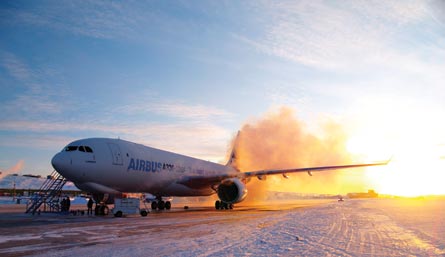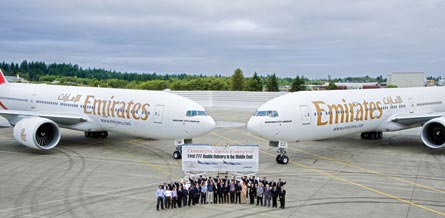While the airline industry awaits the service entry of the Airbus A350 XWB and Boeing 787, ordering of stalwart in-production widebodies continues - for certain types.
The airframers' single-aisle products may largely mirror each other, but their twin-aisle offerings are less closely aligned. Notably, the Airbus A330 spans the capacities of two Boeing types, the upper end of the 767 and the lower range of the 777. The A340-500/600 more closely relate to the 777-200LR/300ER.
One of the three types is quickly dealt with. The A340 appears to be rapidly nearing the end of its production life. The four-engine type had an order backlog of just seven at the end of 2009 and only two additional orders - of -500 models - had been booked by 30 September this year.
|
|---|
The twin-engined A330 has been faring rather better. Its -200F freighter variant was to the fore this year: it followed its first flight in November 2009 with a first revenue flight, with Etihad Crystal Cargo, in September. The model's prospects brightened as fuel costs rose, making it a more attractive replacement for McDonnell Douglas DC-10Fs around the world. The latter aircraft's much lower acquisition costs compared with the A330-200F had previously compensated for its higher fuel-burn, but as aviation spirit rose in price the size of that gap started to narrow.
|
|---|
However, tapping the potentially huge market in re-equipping the fleets of freight integrators such as UPS and FedEx will require a cargo version of the larger A330-300, which would have around 20% more volume - important to the integrators, which tend to ship large quantities of relatively light package, meaning aircraft tend to bulk out before they weigh out.
On the passenger front, the A330 received a fillip from frustrated Boeing 787 purchasers, who found themselves with an urgent need for interim capacity as Seattle's mid-range offering slid steadily to the right on their planning charts.
Interest in the A330-200 is likely to be sustained by the type's planned 5t rise in maximum take-off weight. This improvement is now coming off the production lines and equates to an increase in range of some 330nm (610km) to 6,810nm, or an extra 3.4t of payload. This modification will also be available as a retrofit for A330-200s built from early 2004.

However, competition has come from improvements to the Boeing 777-300ER, which is benefiting from a recent engine and aerodynamics improvement package that cuts both drag and weight. More design changes came in March, including possible extension of the wingspan, with a targeted service entry of the fourth quarter of 2012. Even more major changes are being considered, including a composite wing and new powerplant.
Other increments have included a 2,270kg (5,000lb) increase in maximum zero fuel weight that will give an equivalent payload increase of 20-25 passengers, while the GE90-115B1 will improve thrust by 1-2.5% as part of an enhanced thrust management package to increase take-off weight at higher-altitude airports.
These improvements can be seen as a pre-emptive strike to minimise any advantage that the new Airbus A350-900 may enjoy when it enters service. The Seattle offering is already doing well on the sales charts, typified by Emirates' Farnborough order for 30 777-300ERs.
Meanwhile, Boeing aims to regain production tempo of seven 777s a month by mid-2011, six months earlier than previously planned. In the recession the rate dipped briefly to five.
Source: Flight International


























